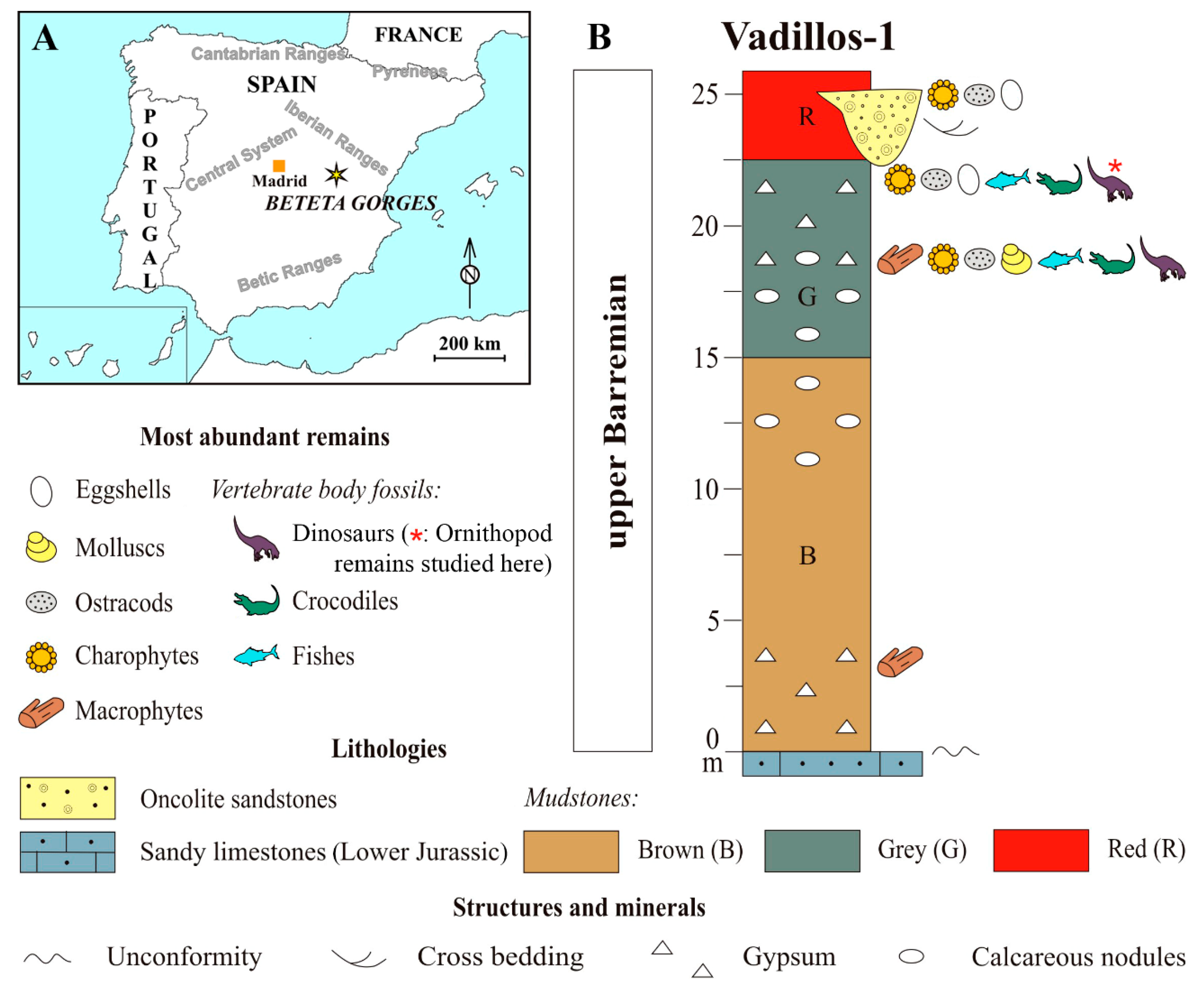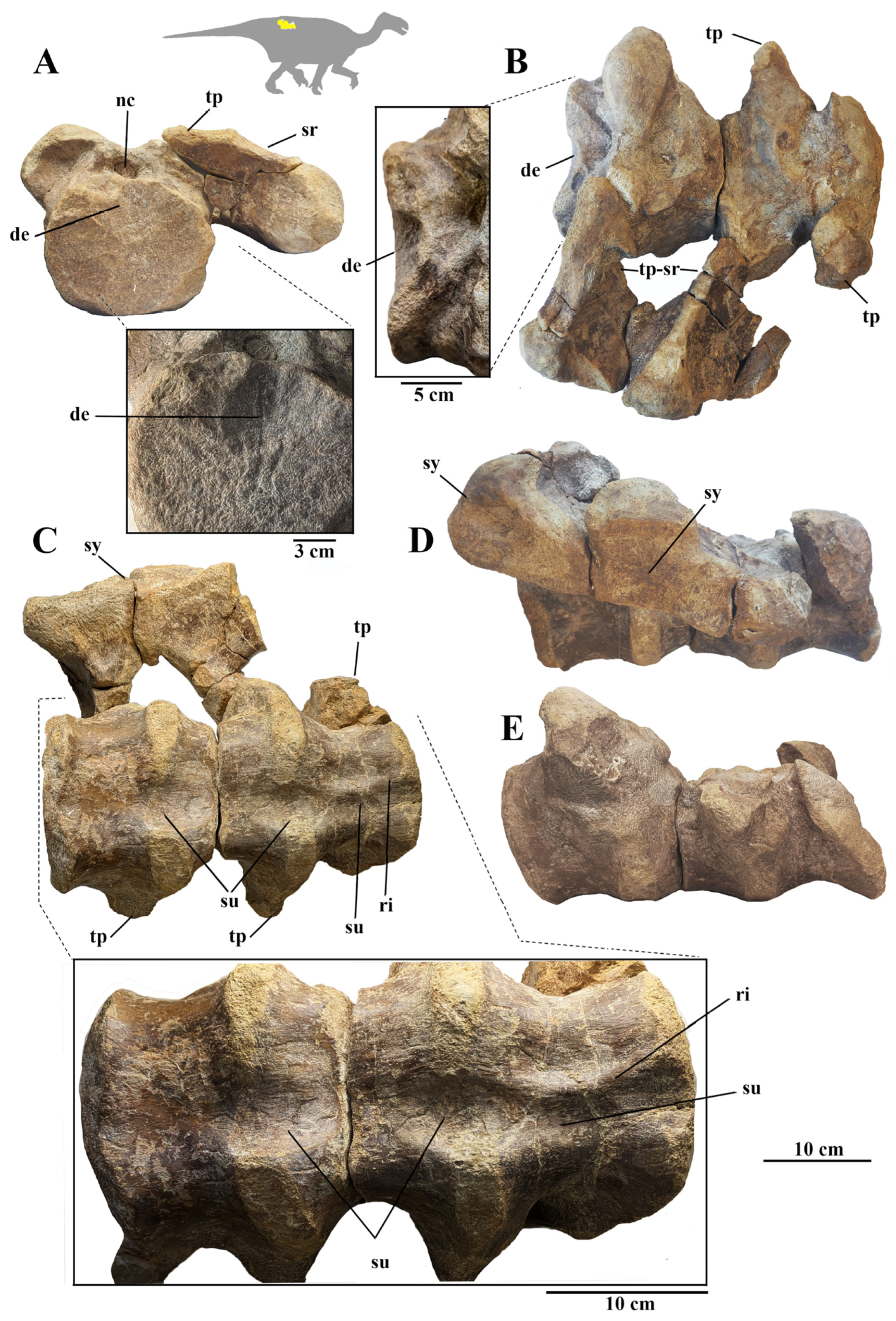New Ornithopod Remains from the Upper Barremian (Lower Cretaceous) of Vadillos-1 (Cuenca, Spain)
Abstract
1. Introduction
2. Geological and Geographical Setting
3. Materials and Methods
4. Systematic Paleontology
5. Discussion
6. Conclusions
Author Contributions
Funding
Institutional Review Board Statement
Informed Consent Statement
Data Availability Statement
Acknowledgments
Conflicts of Interest
References
- Sereno, P.C. Phylogeny of the bird-hipped dinosaurs (order Ornithischia). Natl. Geogr. Res. 1986, 2, 234–256. [Google Scholar]
- Norman, D.B. On the Ornithischian Dinosaur Iguanodon bernissartensis from the Lower Cretaceous of Bernissart (Belgium); Institut Royal des Sciences Naturelles de Belgique: Brussels, Belgium, 1980; Volume 178, pp. 1–103. [Google Scholar]
- Norman, D.B. On the Anatomy of Iguanodon atherfieldensis (Ornithischia: Ornithopoda); Institut Royal des Sciences Naturelles de Belgique: Brussels, Belgium, 1986; Volume 56, pp. 281–372. [Google Scholar]
- Norman, D.B. On the osteology of the lower Wealden Group (Valanginian) ornithopod Barilium dawsoni (Iguanodontia: Styracosterna). Spec. Pap. Palaeontol. 2011, 86, 165–194. [Google Scholar]
- Norman, D.B. Ornithopod dinosaurs. In English Wealden Fossils; Batten, D.J., Ed.; The Palaeontological Association: London, UK, 2011; pp. 405–475. [Google Scholar]
- Norman, D.B. On the taxonomy and diversity of Wealden iguanodontian dinosaurs (Ornithischia: Ornithopoda). Rev. Paleobiol. 2013, 32, 385–404. [Google Scholar]
- Norman, D.B. On the history, osteology, and systematic position of the Wealden (Hastings group) dinosaur Hypselospinus fittoni (Iguanodontia: Styracosterna). Zool. J. Linn. Soc. 2015, 173, 92–189. [Google Scholar] [CrossRef]
- Martin, V.; Buffetaut, E. Iguanodon (Ornithischia-Ornithopoda) du Crétacé Inférieur de la région de Saint-Dizier, Haute-Marne. Rev. Paleobiol. 1992, 11, 67–96. [Google Scholar]
- Knoll, F. A large iguanodont from the upper Barremian of the Paris Basin. Geobios 2009, 42, 755–764. [Google Scholar] [CrossRef]
- Figueiredo, S.; Rosina, P.; Figuti, L. Dinosaurs and other vertebrates from the Papo-Seco Formation (Lower Cretaceous) of southern Portugal. J. Iber. Geol. 2015, 41, 301–314. [Google Scholar] [CrossRef]
- Lockwood, J.A.F.; Martill, D.M.; Maidment, S.C.R. A new hadrosauriform dinosaur from the Wessex Formation, Wealden Group (Early Cretaceous), of the Isle of Wight, southern England. J. Syst. Palaeontol. 2021, 19, 847–888. [Google Scholar] [CrossRef]
- Boulenger, G.A. Rapport de P.J. Van Beneden “Sur l’arc pelvien chez les dinosauriens de Bernissart par M. G. A. Boulenger”. Bull. Acad. R. Sci. Lett. Beaux-Arts Belg. 1881, 1, 600–608. [Google Scholar]
- Gasulla, J.M.; Escaso, F.; Ortega, F.; Sanz, J.L. New hadrosauriform cranial remains from the Arcillas de Morella Formation (Lower Aptian) of Morella, Spain. Cretac. Res. 2014, 47, 19–24. [Google Scholar] [CrossRef]
- Gasulla, J.M. Los Dinosaurios de la Cantera del Mas de la Parreta, Morella (Formación Morella, Barremiense Superior, Cretácico Inferior): Sistemática, Análisis Filogenético e Implicaciones Paleobiológicas. Ph.D. Thesis, Universidad Autónoma de Madrid, Madrid, Spain, 2015. [Google Scholar]
- Gasulla, J.M.; Escaso, F.; Narváez, I.; Sanz, J.L.; Ortega, F. New Iguanodon bernissartensis axial bones (Dinosauria, Ornithopoda) from the Early Cretaceous of Morella, Spain. Diversity 2022, 14, 63. [Google Scholar] [CrossRef]
- Sanguino, F.; Buscalioni, A.D. The Iguanodon locality of Pata la Mona (upper Barremian, Buenache de la Sierra, Cuenca) revisited. In Proceedings of the XVI Encuentro de Jóvenes Investigadores en Paleontología, Zarautz, Spain, 11–14 April 2018; pp. 103–106. [Google Scholar]
- Hooley, R.W. On the skeleton of Iguanodon atherfieldensis sp. nov. from the Wealden Shales of Atherfield (Isle of Wight). Quart. J. Geol. Soc. Lond. 1925, 81, 1–61. [Google Scholar] [CrossRef]
- Llandres Serrano, M.L.; Vullo, R.; Marugán-Lobón, J.; Ortega, F.; Buscalioni, Á.D. An articulated hindlimb of a basal iguanodont (Dinosauria, Ornithopoda) from the Early Cretaceous Las Hoyas Lagerstätte (Spain). Geol. Mag. 2013, 150, 572–576. [Google Scholar] [CrossRef]
- Gasulla, J.M.; Escaso, F.; Narváez, I.; Ortega, F.; Sanz, J.L. A new sail-backed styracosternan (Dinosauria: Ornithopoda) from the Early Cretaceous of Morella, Spain. PLoS ONE 2015, 10, e0144167. [Google Scholar] [CrossRef]
- Verdú, F.J.; Royo-Torres, R.; Cobos, A.; Alcalá, L. Perinates of a new species of Iguanodon (Ornithischia: Ornithopoda) from the lower Barremian of Galve (Teruel, Spain). Cretac. Res. 2015, 56, 250–264. [Google Scholar] [CrossRef]
- Verdú, F.J.; Royo-Torres, R.; Cobos, A.; Alcalá, L. New systematic and phylogenetic data about the Early Barremian Iguanodon galvensis (Ornithopoda: Iguanodontoidea) from Spain. Hist. Biol. 2018, 30, 437–474. [Google Scholar] [CrossRef]
- Fuentes-Vidarte, C.; Meijide-Calvo, M.; Meijide-Fuentes, F.; Meijide-Fuentes, M. Un nuevo dinosaurio estiracosterno (Ornithopoda: Ankylopollexia) del Cretácico Inferior de España. Span. J. Palaeontol. 2016, 31, 407–446. [Google Scholar] [CrossRef]
- Santos-Cubedo, A.; de Santisteban, C.; Poza, B.; Meseguer, S. A new styracosternan hadrosauroid (Dinosauria: Ornithischia) from the Early Cretaceous of Portell, Spain. PLoS ONE 2021, 16, e0253599. [Google Scholar] [CrossRef]
- De Lapparent, A.F.; Curnelle, R.; Defaut, B.; Miroschedji, A.d.; Pallard, B. Nouveaux gisements de Dinosaures en Espagne Centrale. Estud. Geol. 1969, 25, 311–315. [Google Scholar]
- Ruiz-Omeñaca, J.I.; Canudo, J.I. Dinosaurs (Saurischia, Ornithischia) in the Barremian (Lower Cretaceous) of the Iberian Peninsula. In Dinosaurios y Otros Reptiles Mesozoicos en España; Pérez-Lorente, F., Ed.; Instituto de Estudios Riojanos: Logroño, Spain, 2003; pp. 269–312. [Google Scholar]
- Barroso-Barcenilla, F.; Berrocal-Casero, M.; Blain, H.A.; Callapez, P.M.; Cambra-Moo, O.; Escaso, F.; Martín-Closas, C.; Ortega, F.; Pérez-García, A.; Prieto, I.; et al. Geological and palaeontological context of three new Barremian vertebrate sites in the Iberian Peninsula (Lower Cretaceous, Cuenca, Spain). Proc. Geol. Assoc. 2017, 128, 256–270. [Google Scholar] [CrossRef]
- Poyato-Ariza, F.J.; Talbot, M.R.; Fregenal-Martínez, M.A.; Meléndez, N.; Wenz, S. First isotopic and multidisciplinary evidence for nonmarine coelacanths and pycnodontiform fishes: Palaeoenvironmental implications. Palaeogeogr. Palaeoclimatol. Palaeoecol. 1998, 144, 65–84. [Google Scholar] [CrossRef]
- Bravo, A.M.; Sevilla, P.; Barroso-Barcenilla, F. Avian and crocodilian eggshells from the upper Barremian site of Vadillos-1 (Lower Cretaceous, Cuenca Province, Spain). Cretac. Res. 2018, 85, 28–41. [Google Scholar] [CrossRef]
- Fregenal-Martínez, M.; Meléndez, N.; Muñoz-García, M.B.; Elez, J.; Horra, R.d.l. The stratigraphic record of the Late Jurassic–Early Cretaceous rifting in the Alto Tajo–Serranía de Cuenca Region (Iberian Ranges, Spain): Genetic and structural evidences for a revision and a new lithostratigraphic proposal. Rev. Soc. Geol. Esp. 2017, 30, 113–142. [Google Scholar]
- Berrocal-Casero, M.; Alcalde-Fuentes, M.R.; Audije-Gil, J.; Sevilla, P. Theropod teeth from the upper Barremian (Lower Cretaceous) of Vadillos-1 (Spain). Cretac. Res. 2023, 142, 105392. [Google Scholar] [CrossRef]
- Díez-Somolinos, M.; Barroso-Barcenilla, F.; Berrocal-Casero, M.; Rodríguez-Lázaro, J.; Sevilla García, P.; Sames, B. New species of ostracods from the non-marine upper Barremian (Lower Cretaceous) of Vadillos-1 (Cuenca, Spain). Cretac. Res. 2025. under review. [Google Scholar]
- Sevilla, P.; Audije-Gil, J.; Berrocal-Casero, M.; Prieto, I.; Barroso-Barcenilla, F. Primeros hallazgos de restos de mamíferos en el yacimiento de Vadillos-1 (Hoces de Beteta, Cuenca). Palaeontol. Publ. 2022, 2, 3181. [Google Scholar]
- Ruiz-Galván, A.; Barroso-Barcenilla, F.; Ortega, F.; Sevilla, P. Crocodyliform dental remains from the Lower Cretaceous sites of the Beteta Gorges (Cuenca, Spain). In A Glimpse of the Past; Abstract Book XV Encuentro Jóvenes Investigadores en Paleontología/XV Encontro de Jovens Investigadores em Paleontologia; Barrios de Pedro, S., Moreno, C.B., de Celis, A., Colmenar, J., Cuesta, E., Martínez, D.G., Gascó, F., Jacinto, A., Malafaia, E., Jiménez, M.M., et al., Eds.; XV EJIP: Lisboa, Portugal, 2017; pp. 353–355. [Google Scholar]
- Prieto, I.; Barroso-Barcenilla, F.; Cambra-Moo, O.; Sevilla, P. Taphonomic approach to the vertebrate remains of the “Hoces de Beteta” Lower Cretaceous sites (Cuenca, Central Spain). In Proceedings of the XIV Encuentro de Jóvenes Investigadores en Paleontología-I International Meeting of Early-Stage Researchers in Palaeontology; Manzanares, E., Ferrón, H.G., Suñer, M., Holgado, B., Crespo, V.D., Mansino, S., Fagoaga, A., Marquina, R., García-Sanz, I., Martínez-Pérez, C., et al., Eds.; Ayuntamiento de Alpuente: Valencia, Spain, 2016; p. 7. [Google Scholar]
- Lindsay, W. A review of the acid technique. In The Care and Conservation of Palaeontological Material; Collins, C., Ed.; Butterworth-Heinemann: Oxford, UK, 1995; pp. 99–105. [Google Scholar]
- Leiggi, P.; May, P. (Eds.) Vertebrate Paleontological Techniques; Cambridge University Press: Cambridge, UK, 2005; Volume 1, 366p. [Google Scholar]
- Davidson, A.; Alderson, S.; Fox, M. Assembling an archival marking kit for paleontological specimens. J. Vertebr. Paleontol. 2006, 26, 54A. [Google Scholar]
- Owen, R. Report on British fossil reptiles, Part II. Rep. Br. Assoc. Adv. Sci. 1842, 11, 60–204. [Google Scholar]
- Seeley, H.G. On the classification of the fossil animals commonly named Dinosauria. Proc. R. Soc. Lond. 1887, 43, 165–171. [Google Scholar]
- Marsh, O.C. Principal Characters of American Jurassic Dinosaurs. Part V. Am. J. Sci. 1881, 21, 417–423. [Google Scholar] [CrossRef]
- Mantell, G.A. Notice on the Iguanodon, a newly discovered fossil reptile, from the sandstone of Tilgate Forest in Sussex. Philos. Trans. R. Soc. Lond. 1825, 115, 179–186. [Google Scholar]
- Paul, G.S. A revised taxonomy of the iguanodont dinosaur genera and species. Cretac. Res. 2008, 29, 192–216. [Google Scholar] [CrossRef]
- Horner, J.R.; Weishampel, D.B.; Forster, C.A. Hadrosauridae. In The Dinosauria, 2nd ed.; Weishampel, B., Dodson, P., Osmolska, H., Eds.; University of California Press: Berkeley, CA, USA, 2004; pp. 438–463. [Google Scholar]
- Verdú, F.J.; Godefroit, P.; Royo-Torres, R.; Cobos, A.; Alcalá, L. Individual variation in the postcranial skeleton of the Early Cretaceous Iguanodon bernissartensis (Dinosauria: Ornithopoda). Cretac. Res. 2017, 74, 65–86. [Google Scholar] [CrossRef]
- Hübner, T. The postcranial ontogeny of Dysalotosaurus lettowvorbecki (Ornithischia: Iguanodontia) and implications for the evolution of ornithopod dinosaurs. Palaeontogr. Abh. 2018, 310, 43–120. [Google Scholar] [CrossRef]
- Lockwood, J.A.F.; Martill, D.M.; Maidment, S.C.R. Comptonatus chasei, a new iguanodontian dinosaur from the Lower Cretaceous Wessex Formation of the Isle of Wight, Southern England. J. Syst. Palaeont. 2024, 22, 2346573. [Google Scholar] [CrossRef]
- García-Cobeña, J.; Verdú, F.J.; Cobos, A. Abundance of large ornithopod dinosaurs in the El Castellar Formation (Hauterivian-Barremian, Lower Cretaceous) of the Peñagolosa sub-basin (Teruel, Spain). J. Iber. Geol. 2022, 48, 107–127. [Google Scholar] [CrossRef]
- Bonsor, J.A.; Lockwood, J.A.F.; Leite, J.V.; Scott-Murray, A.; Maidment, S.C.R. The osteology of the holotype of the British iguanodontian dinosaur Mantellisaurus atherfieldensis. Monogr. Palaeont. Soc. 2023, 177, 1–63. [Google Scholar] [CrossRef]
- Norman, D.B. Iguanodontian taxa (Dinosauria: Ornithischia) from the Lower Cretaceous of England and Belgium (Chapter 15). In Bernissart Dinosaurs and Early Cretaceous Terrestrial Ecosystems; Godefroit, P., Ed.; Indiana University Press: Bloomington, IN, USA, 2012; pp. 175–212. [Google Scholar]
- García-Cobena, J.; Verdú, F.J.; Cobos, A. Systematic of a massively constructed specimen of Iguanodon galvensis (Ornithopoda, Iguanodontidae) from the early Barremian (Early Cretaceous) of Eastern Spain. Diversity 2024, 16, 586. [Google Scholar] [CrossRef]




| Vertebrae | Anterior–Posterior Length (cm) | Dorsoventral Height (cm) | Transverse Width (Anterior Articular Facet) (cm) | Transverse Width (Posterior Articular Facet) (cm) |
|---|---|---|---|---|
| VDI-511 most posterior | 10 | 13.5 | 16.5 | 15.5 |
| VDI-511 middle | 10.5 | 11.5 | ≃17.5 | ≃16.5 |
| VDI-511 more anterior | 11 | 10.5 | Non-measurable | ≃18 |
| VD1-403 Isolated sacral | 11.5 | 11.3 | 10.6 | 12.5 |
Disclaimer/Publisher’s Note: The statements, opinions and data contained in all publications are solely those of the individual author(s) and contributor(s) and not of MDPI and/or the editor(s). MDPI and/or the editor(s) disclaim responsibility for any injury to people or property resulting from any ideas, methods, instructions or products referred to in the content. |
© 2025 by the authors. Licensee MDPI, Basel, Switzerland. This article is an open access article distributed under the terms and conditions of the Creative Commons Attribution (CC BY) license (https://creativecommons.org/licenses/by/4.0/).
Share and Cite
Berrocal-Casero, M.; Barroso-Barcenilla, F.; Callapez, P.M.; Pimentel, R.; Alcalde-Fuentes, M.R.; Prieto, I. New Ornithopod Remains from the Upper Barremian (Lower Cretaceous) of Vadillos-1 (Cuenca, Spain). Foss. Stud. 2025, 3, 5. https://doi.org/10.3390/fossils3010005
Berrocal-Casero M, Barroso-Barcenilla F, Callapez PM, Pimentel R, Alcalde-Fuentes MR, Prieto I. New Ornithopod Remains from the Upper Barremian (Lower Cretaceous) of Vadillos-1 (Cuenca, Spain). Fossil Studies. 2025; 3(1):5. https://doi.org/10.3390/fossils3010005
Chicago/Turabian StyleBerrocal-Casero, Mélani, Fernando Barroso-Barcenilla, Pedro Miguel Callapez, Ricardo Pimentel, María Rosario Alcalde-Fuentes, and Irene Prieto. 2025. "New Ornithopod Remains from the Upper Barremian (Lower Cretaceous) of Vadillos-1 (Cuenca, Spain)" Fossil Studies 3, no. 1: 5. https://doi.org/10.3390/fossils3010005
APA StyleBerrocal-Casero, M., Barroso-Barcenilla, F., Callapez, P. M., Pimentel, R., Alcalde-Fuentes, M. R., & Prieto, I. (2025). New Ornithopod Remains from the Upper Barremian (Lower Cretaceous) of Vadillos-1 (Cuenca, Spain). Fossil Studies, 3(1), 5. https://doi.org/10.3390/fossils3010005







